Art of the Genre: Remember folks, The Hobbit is a Children’s Novel!
Ok, so I’m reading J.R.R. Tolkien’s The Hobbit, probably for the 4th time in my life. I mean, at this point, who isn’t reading it? With the new Peter Jackson film coming to theaters near you, anyone who loves the book is probably going back for another helping to refresh themselves as to why it made such an impact on their lives in the first place.
I’ve been following the Jackson blogs on the subject, seen the video footage and trailers, and am anxiously anticipating the release, but I can’t help wonder where the true ‘wonder’ went? You see, The Hobbit, for all intents and purpose is a YA novel, and no I’m not talking about stuff like Twilight or the last 5 Harry Potter books, but something more whimsical and genuinely fun.
Tolkien narrates The Hobbit, and that in itself creates a children’s magic in the tale as it distances you from the reality of it all and keeps everyone listening to it safe by an imagined fire and at the knee of a loving parent. He keeps the bulk of the tale light, and combat is reserved for times best suited to drive a point home while not featuring the violence of the scene.
I remember well first reading this book, probably within a year of my initial role-playing game experience with D&D, and thinking ‘why the heck don’t these dwarves have weapons!?’. I mean could ANY book in this day and age get away with 14 characters starting a quest to kill a dragon without a single blade among them? The short answer, is no, but the longer one delves more deeply into the dark subconscious of America’s post baby-boom generations, yet I’m not going to get into that here.
Instead, I’ll look at what Tolkien gives us in the way of ‘adventure’. Sure, eventually Thorin gains Orcrist, and Bilbo Sting, but the former is simple window dressing until the Battle of Five Armies and the deathly combats observed there. The later, Sting, is employed, but only in very ‘roguish’ ways and even armor isn’t had until the very end of the book.
The most powerful wizard in the world, Gandalf, doesn’t throw a spell save for some illusion at the Goblin Gate, and yet we truly believe in his ability to do so.
In this fashion Tolkien employs the great talent of ‘less is more’, and I truly admire him for it. The Hobbit then becomes something completely different from Lord of the Rings, and yet when I watch Jackson’s version of the events I see little to no difference between the cinematic takes on Tolkien’s two great works.
This then, brings sadness to me. It’s not that I’ll go without watching and surely enjoying this newest version, but that I fully understand times have changed so much that in today’s warmongering Halo and Medal of Honor society it’s no longer acceptable to make movies with heart and not action.
Still, like me, there are those who believe in a truer vision of Tolkien’s work on this book, and as I’ve gone deep into There and Back Again I found a kind of kindred spirit in artist Justin Gerard.
Gerard, while having a lull in his work schedule, decided to try to capture Tolkien’s first work in the whimsy of watercolor, my personal favorite medium, and what he came up with was truly inspired.
Once I saw his work, I had to share it with my readers here because it was so very different from what is normally seen, and there was still a childlike innocence to it that stayed true to the source material.
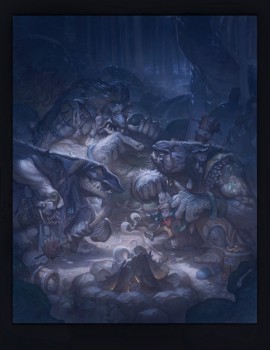 Gerard cataloged his personal adventures inside the creation of these wonderful images on his blog, but I felt I wanted a bit more, so I contacted him concerning his work. The following 10 questions are a great read if you enjoy the artwork featured in this article:
Gerard cataloged his personal adventures inside the creation of these wonderful images on his blog, but I felt I wanted a bit more, so I contacted him concerning his work. The following 10 questions are a great read if you enjoy the artwork featured in this article:
BG: In the beginning of the novel the dwarves come off as more multi-colored garden gnomes with very silly rhyming names. What motivated you to change them in your version?
JG: I’m not sure. The dwarves never quite came off as garden gnomes for me. It may be because I read things a bit out of order when I was young though. I read the Lord of the Rings before I read the hobbit. And the references to “grim dwarves” and dwarves with great axes who slew orcs may have dispelled any ideas that the dwarves were silly gnomes in Tolkien’s world. I have always seen them as a little more grim. And I think Tolkien intended them to be more that way as well. In the Silmarillion he talks about their creation as a race, and how they were made from the rocks of the earth. I think he always saw them as a very hardy race, who spent their time in deep caves mining and carving out great halls under the earth, rather than magical gnomes.
BG: I would agree that The Hobbit is a children’s novel, and carries a much different weight than LOTR. Why did that children’s whimsy pull you more to it than the adult themes of LOTR?
JG: Well, I love both stories and I do hope to actually get a chance to do more imagery from the Lord of the Rings in the future. But the Hobbit probably is my favorite of all of Tolkien’s stories. It has a bit more charm to it, and the character’s development in it is very interesting to me. But perhaps most of all it was the monsters in the world, which seemed to be apt personifications of people and agencies I have encountered in life. There is a human quality to them that makes them extremely interesting as subjects for an illustration.
But it wasn’t really whimsy that made me choose it first. I chose it first mostly because Peter Jackson had just released his film versions of the LOTR and I had heard the he was working on the Hobbit. When I had seen the Lord of the Rings, I felt like Jackson’s ideas for places and events and characters had heavily influenced my own. I loved the films, but I liked my own ideas too. So I decided to get my own ideas for the Hobbit down before the films came out.
BG: Hobbits are an ever-changing and much-imagined race. What made you go with the style you chose for them and how would you describe Bilbo’s ‘look’ in your images? 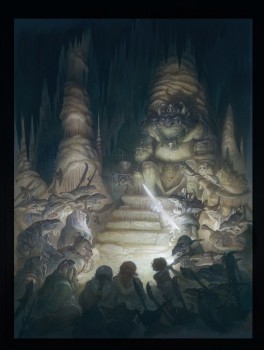
JG: I don’t know exactly. The drawings I did were what were in my head when I read the story. I’m sure they are an amalgamation of many other designs I have seen for hobbits. I’m sure a lot of other things, like pictures of people from the old English countryside, influenced my design as well.
BG: What was the final total on images you did for your project and what made you pick the scenes you did?
JG: It is hard to give a final total because the project is still going on, and there are many images that are either still in development or are currently being worked on. It will be hard to tell how many I will end up with. Likely I will keep working on it (as time permits) up until Peter Jackson’s new films come out. There are so many good scenes in the story! There is still so much left to work on!
I chose the scenes generally based on 2 things:
1. Whether it offered a good opportunity as a chapter illustration (As in, would it give an interesting summary and catch the overall feeling of a chapter)
2. Whether it gave me a chance to tackle an environment or character(s) that I was interested in nailing my own versions of down before I saw the new films.For instance, I knew I was going to do the scene of Bilbo first encountering Smaug both because it seemed to catch the main ideas of that chapter and also because it would allow me to nail down my own ideas about Smaug. A character I had a lot of personal ideas about and was really worried about seeing replaced by someone else’s ideas.
BG: Personal projects are great, but I have to wonder if you’ve ever been approached about the images concerning their use in a print version of the Hobbit? 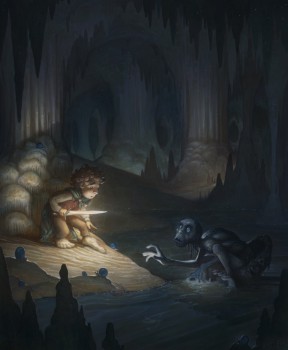
JG: I have. After I finished these images I was approached by a number of people. Ultimately most of the art was picked up by Warner Brothers. Whether these will be used in some kind of future print version or as simply helpful designs for stuff related to the films, I don’t know. I would love to see them contribute to some print version of the hobbit though. It is such a great little story.
BG: If you had to choose a race from the Hobbit that you had the most fun designing and painting, what would it be?
JG: I would want to say the Trolls, but then I would remember how much fun the goblins were, and then I’d remember how much fun Smaug was, and then I’d remember how much fun the dwarves were. So it would be impossible for me to say. They were all such a pleasure to work on.
BG: Did you think you’ll take anything, such as a revelation or inspiration, away from the project when you’ve finally ‘finished’ it?
JG: When I started out with the project one of my goals was to improve my traditional painting method and abilities. I hadn’t been working much traditionally at the time. Most of my work was digital, and I was very interested in getting back into working with actual paint again. One of the greatest things I took away was a greater command over watercolor and of being able to assemble complex images, with many characters in them.
I also left with an even deeper appreciation for Tolkien’s writing and ideas, and a desire to learn more about both.
BG: I know this was done in down time for you in 2009. Have you had any other personal projects you’ve done since then or are any lurking in the future? 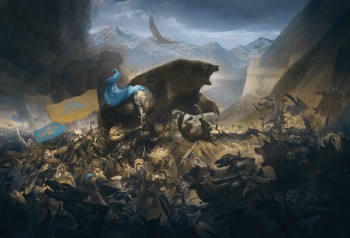
JG: Since then I have worked on a number of other personal projects (one of which never worked out and which no art has ever been shown from, but which I may release some time later). The last one was of St. George and the Dragon, which was released in sketchbook form recently. (You can see the progress of the St. George project here:
Currently I am involved in another project related to Tolkien’s world which I am very excited about and hope to release later on this year.
BG: What non-personal projects are you currently working on now?
JG: I can’t talk much about it yet, but I hope to be able to by early spring. When I do I will be posting the progress of everything related to it on my blog.
BG: If you had a suggestion for anyone going back and reading the Hobbit after many years absence, which I assume a host will do with the new movie coming out, what would it be?
JG: Do it. It is such a great story. And if you can, see if you can find the 1974 audiobook version of it by Argo Records performed by Nicol Williamson. His portrayal of the characters was extremely influential in my designs and I believe he does the best version of the story that is currently out there.
So there you have it, a young man of vision and talent who put his skills to great use when there was nothing else to do. I salute Justin for his work and wish him all the best as his project continues to move forward. And in the end, I know I’m not the only one who felt a certain way about this classic book and how it should play out to those who partake of it.
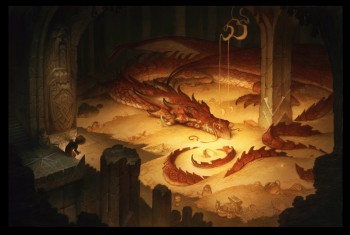
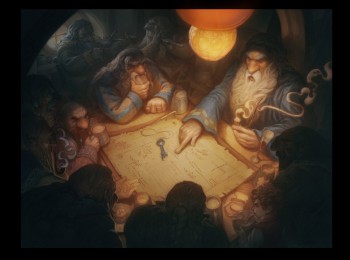
That Beorne picture is so awesome it makes my head spin
Glenn: Justin’s whole project made my head spin! Glad you enjoyed it as well! 🙂
Excellent article Scott! I love the Hobbit. Now I can hope that there may be a newly illustrated edition in the works. And watercolour to boot! The Hobbit was the first truely fantastical book I read by myself as a young adult (5th grade). I remember it so specifically because I started it at night, and then kept going as soon as I woke up the next morning. I stayed in bed all day reading it on a beautiful, sunny summer day when I would normally have been outside building forts and climbing trees. I have been in love with it ever since. I can’t say that I have read all of tolkiens work, but the Hobbit has remained my favorite, followed closely by Farmer Giles of Ham.
The funny thing is that I used to always tell people that The Hobbit is a children’s story and more whimsical than LOTR, yet when I re-read a few months ago I was struck by what a straight-on adventure story it is. That doesn’t mean it’s not a children’s story and lacks whimsy, but I think children’s entertainment before, say, Sesame Street is a totally different thing than children’s entertainment now.
Lovely art by Gerard.
Raptor: See! This is why we get along so well! Well, that and the fact that you are gorgeous! 😉
Andy: A very interesting point! I’m often moved by the introspection of the Battle of Five armies and Bilbo’s non participation in it. I have to think it is Tolkien’s way of blasting WWI and his turn in that horrible war because people just refused to share their wealth…
Beautiful paintings…and the dwarves are far superior to Peter Jackson’s Klingons. 🙂
Thank you for making me aware of this artist.
Tyr: Very glad you enjoyed the art, Gerard is top notch!
Gorgeous! I agree that Beorn is especially well rendered.
Sarah: Beorn is a favorite character of mine, and I was sad Rankin&Bass left him out of their animated version. I’m pretty sure Jackson won’t considering he has two movies to work with for a relatively small book.
The Hobbitt as a children’s book, and as the source of the Lord of the Rings franchise, reminds me of an odd truth of roughly the last thirty or so years. Namely, most of the more prominent media franchises have a basis in children’s entertainment.
http://forums.comicbookresources.com/showthread.php?t=391845&highlight=Flash+Gordon+Star+Wars
http://forums.comicbookresources.com/showthread.php?p=14290611#post14290611
I saw articles in USA Today and Forbes which seemed to indicate that Harry Potter might overtake Star Wars (inspired by the Flash Gordon serials) in terms of domestic box office, per Box Office Mojo.
While it does not appear that they adjusted matters for inflation or took foreign box office into consideration, they did come up with an interesting list of other successful franchises to compare Star Wars and Harry Potter with. I will note where they derive from children’s entertainment. The list included:
Batman (had a boy sidekick in pixie shoes, shaved legs, and leprechaun shoes from 1941-1988)
Shrek (obvious)
Spider-Man (Richard Wentworth’s bastard grand-nephew, without his forerunner’s ruthlessness and firearms)
Pirates of the Caribbean (started as a theme park ride-yes, it started as a theme park ride)
The Lord of the Rings (started with the Hobbit, and the Hobbitt received initial reviews as a children’s book)
Incidentally, none of these franchises have ever had R-rated entries. In fact, R-rated adventure films largely no longer have the prominence they had in the 1970’s and 1980’s (look at the reception of the Mamoa Conan film).
http://www.forbes.com/2010/09/29/star-wars-harry-potter-business-entertainment-movie-franchises.html?boxes=Homepagemostpopular
http://images.businessweek.com/ss/07/08/0808_franchises/index_01.htm
Follow-up article from Business Week
PB210: It makes a great deal of sense because the purity of the stories involved in children’s tales should translate to a much larger range of people. Personally, I love children’s literature.
Mr. Taylor, I find this interesting as attempts to turn adult thriller literature into prolific franchises generally have not panned extraordinarily well, other than Jack Ryan/Tom Clancy and some unplanned franchises such as the Rambo series (one should note, though, that the third and fourth Rambo films actually fell off sharply from the first two films). Nor have R-rated adventure franchises such as “Dirty” Harry Callahan produced the long line of tie-in novels that PG/PG-13 Star Wars has (Warner Books only published roughly 17 “Dirty” Harry Callahan novels in the 1970’s and 1980’s).
http://forums.comicbookresources.com/showthread.php?t=394170
However, although the more prominent franchises as I have shown tend to derive from children’s entertainment, the writers themselves often prefer to write crime and more grounded espioange stories (more Tom Clancy than Spy Kids espionage stories).
http://www.blackgate.com/2011/06/19/thor-and-the-fear-of-fantasy/
“In general, it seems that the current wave of creators at Marvel is….. perhaps more comfortable with crime and espionage stories than either”. (Frank Miller serves as an example of this situation; he notes in various places his preference for private eye writers to sword and sorcery authors. However, in the last thirty or so, prominent sword and sorcery films have arisen, while private eye films have largely disappeared from theaters.)
In Michael Medved’s Book Hollywood vs. America, Medved noted that many people who attend film school prefer to think of themselves as aspiring towards the status of Martin Scorsese, well-known for his crime dramas, not Robert Zemeckis, who makes high concept whimsy.
Historically, other than horror films, paranormal films have tended to fall towards children’s films (Alice in Wonderland, Wizard of Oz), while adaptations of crime fiction writers such as W.R. Burnett had a more lofty reputation, so I suppose this explains this preference. Also, paranormal adventure series tended not to sell as well as more grounded adventure series prior to the late 1960’s (notice how so many of the “classic” space heroes-Superman, Flash Gordon-started in comic strips/comic books and so forth). Superman and Flash Gordon may have received many homages in television in the 1960’s and early 1970’s, but they did not make the New York Times best-seller lists.
Of course, the FTC has stricter rules about advertising R-rated films since 2001, so that may explain the prominence of films derived from children’s literature today. It does not explain Star Wars’ prominence in the 1970’s and 1980’s, the era of the “Dirty” Harry Callhan films, though.
PB210: That’s a very interesting topic, and you show great knowledge of the material. You ever think about blogging here on Black Gate 😉